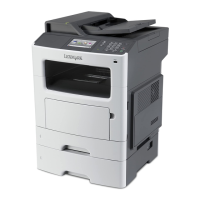We recommend that you condition stock while it is still in the original wrapper. To condition stock, store it in the same
environment as the printer for 24–48 hours before printing to let the stock stabilize at the new conditions. You may
need to extend this time by several days if the storage or transportation environment is very different from the printer
environment. Thick stock may also require a longer conditioning period because of the mass of the material.
If you remove the wrapper from the stock before you are ready to load it in the printer, the stock may develop uneven
moisture content that can cause curl. Prior to loading your stock, we recommend that curl not exceed 3 mm (0.125 in.).
Lighter materials, such as paper labels and some integrated forms, are more likely to have printing problems if curl is
present.
Most label manufacturers recommend printing in a temperature range of 18–24°C (65–75°F) with relative humidity of
40–60%. Lexmark printers are designed to operate in a temperature range of 15.5–32°C (60 to 90°F) with relative
humidity of 8 to 80%. Printing in an environment outside these recommendations may cause jams, feeding problems,
reduced print quality, and predispensing (peeling) labels.
Inks (preprinted stock)
Preprinted stock introduces semi‑liquid and volatile components to the high temperatures and pressure used in the
laser printing process. Preprinted inks and colorations must withstand a fuser temperature up to 225°C (437°F) and
pressure up to 25 psi without contaminating the printer or creating hazardous fumes.
Thermography inks are not recommended. Thermography inks have a waxy feel and the printed image appears raised
above the surface of the print material. These inks can melt and damage the fuser assembly.
Preprinted inks must also be abrasion resistant to reduce ink dust and ink contamination in the printer. If you are
printing over a preprinted area, the ink must be receptive to toner to ensure adequate fusing.
All preprinted inks must be thoroughly dry before using printed materials. However, we do not recommend using offset
powders or other foreign materials to speed drying. Check with your converter, or the manufacturer or vendor of the
ink you plan to use, to determine if the ink is compatible with laser printers that heat the ink to 225°C (437°F).
Perforations and die‑cuts
If your form has perforations, the perforation line should stop 1.6 mm (0.06 in.) from each edge of the form to avoid
separating the form in the printer path, resulting in a jam. The location of the perforation affects initial pick strength.
Perforations closer to the edge may increase the number of jams. For pressure‑sensitive materials such as labels,
minimize the number of perforations that go through the backing material, or liner, since these can also affect the
strength of the form.
Perforations should be ironed so the print material lies flat, reducing nesting of forms. Edges should be smooth and
clean with no roll‑over. Laser
‑
perfs (also known as micro
‑
perfs or data
‑
perfs) provide greater stability and are preferred.
These smaller perforations do not normally nest or create excessive paper dust and debris. Make sure paper chaff and
dust created during the conversion process are removed before packaging.
If perforations tent, or crease at the perforation line, the perfs may break, causing a paper jam. Tenting may increase
skew, cause double‑sheet feeding, or smear the toner on the print material before fusing, resulting in poor print quality.
To reduce tenting, use micro‑perfs. If the print material is lightly snapped as it moves through the printer, the
perforations should hold without breaking.
Die
‑
cutting is used to create shapes in a label or a card stock design. When designing labels, round all corners to prevent
delamination of the labels, and avoid cuts through the liner (anvil cuts). Back splits and pop‑out windows are also not
recommended.
If perforations or die‑cuts are part of the design of the print material, ties are recommended. These small uncut areas
(approximately 1.6 mm or 0.06 in.) help stabilize the form and prevent tearing at perforations and die‑cuts during
printing.
General information 10

